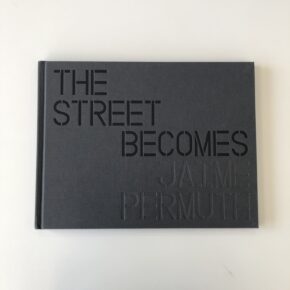Sometimes, art can change our lives, or at least how we relate to the world around us. Writing in The New Yorker last week, Peter Schjeldahl mentioned that when he emerged from a recent visit to the new Islamic galleries at the Metropolitan Museum of Art, he felt like a slightly different person. Other times, though, it’s just nice to look at photographs that depict a different way of life in a foreign culture, far far away. It’s simple human curiosity, really: travel, for the recession age. So this week’s books are unlikely to give you an Earth-shaking epiphany that makes you to quit your job, or give up your life to Jesus. But they ought to satisfy an inherent desire to look outward towards chaos of humanity, and come back with a shade more context about your own little world.
“Zapallal/Yurinaki” is a new hardcover monograph by Andrés Marroquín Winkelmann, published by MA+GO Concept, and distributed by Misha de Kominek Gallery in Berlin. It’s kind of a funky production, as the blue, cloth-bound spine melds into a cardboard cover with a photograph glued to the top. It has the feel of a high-end arts and crafts project, but not in a bad way. (The text is presented in English, Spanish and German, so we know the audience is meant to be Global.) Inside, the first few pages are cut to different sizes, so it opens up bit by bit, You can see right away that the book depicts village life in Peru, with it’s attendant ducks, chickens, pigs, sheep and cats. Mr. Winkelmann apparently photographed in two different communities in Peru, but it’s not particularly evident in the images. Instead, you get a spate of well-seen, flash-driven contemporary documentary photographs of a place that doesn’t look like where you live. Dirty walls, dirt roads, junk in the backyard, meditative still lives of produce, that sort of thing. A particular favorite was a photograph of a young girl, the pink scrunchy on top of her head just peeking out above a kitchen table, while a generic, framed photo of a Caucasian grandfather kissing his grandson haunts the upper left hand corner of the composition. (It’s got to be the picture that came with the frame, right?)
Bottom Line: Peru
To purchase Zapallal/Yurinaki visit Photo-Eye
“The Brothers,” recently released by Dewi Lewis Publishing, is a black, hardcover book by photographer Elin Hølyand. Two, shirtless, bug-eyed old dudes stare out from the cover, one with a rifle slung over his shoulder. The brothers, I presume. Harald and Mathais, both now deceased, lived together as bachelors on the family farm in rural Norway for their entire lives. It was an old-school, hardscrabble existence, by all appearances. The project was shot in grainy black and white, yet never feels like it was done a long time ago. The photos read modern, for some reason, which could just be that there are enough temporal signifiers to get the point across. There are several double paged spreads where we see both gentlemen, ever so slightly different, like multiple versions of the same guy residing in parallel universes. All bushy eyebrows and plaintive stares…it’s almost enough to make me sad these men are gone, despite the obvious fact that I never met them. Ms. Høyland’s sensibility is odd and strange, but never veers towards creepy or cliché. It’s a terrific collection of photographs, and well printed too.
Bottom Line: Norway
To purchase The Brothers visit Photo-Eye
Finally, we come to “The Submerged,” by Michelle Sank. It’s a smooth, hard cover book recently offered by Schilt Publishing in Amsterdam. (Insert random stoner reference here…) Ms. Sank, peripatetic through a slew of artist residencies, apparently spent a few months in Wales, and this book is the result. Wales? It reminds me of that Wayne’s World joke where they mocked Delaware. Wales is not the first place I would salivate to go, but that’s part of the fun of looking at these books. What does it look like? What kind of people actually live there? I could tell you, but then you’d have no reason to browse the photos below. The whole selection of images is just the slightest bit weird, but in a subtle way. Like the Beauty Queen in mud covered boots, the Hasidic Jews frolicking on the beach, or the pudgy, dough-faced metalhead in the Ozzy Osborne T-shirt. Not to give away the best part, like a Hollywood preview, but the image of a forlorn, abandoned hilltop barn with “Twat” spray-painted on the side is a keeper. The more I look at it, the more I see a funnier, less genius, contemporary take on August Sander.
Bottom Line: Wales
To purchase The Submerged visit Photo-Eye
Full Disclosure: Books and scans were provided by Photo-Eye in exchange for links back for purchase. Please support Photo-Eye if you find this feature useful.




















3 Comments
I like it, “Brothers” that is. I will have to add it to my buy list. It is not often that I will by a photography book like this. It looks well worth the a couple of Jacksons and a Lincoln to add it to the library. Thanks JB.
How long those a picture remain on our optic nerve befour giving way for the next? I can assure you that it is infinitesimaly minute, though it goes on as stored data in your brain, but we have so many of them that the chance that we’ll have the will power to access it anytime soon, depends on a host of other circumstance, but a picture, a snpshot, a still phota, now that can last a lifetime, or several depending on presevation, there is no substitute to good old fashion photographs.
iamtheeagle.blogspot.com
Some thought provoking images here.
Comments are closed for this article!